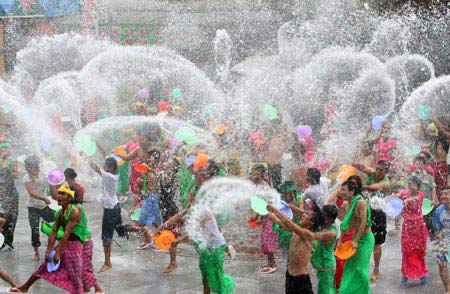Off to Phnom Penh
From Siem Reap we took a 5 hour bus journey to Phnom Penh. Mike was due to leave SE Asia on the 16th of April, two days after we arrived in the capital. On the bus trip we met an Australian woman whose parents had grown up in Cambodia. She was back visiting family and also happened to be leaving the same day from Phnom Penh. We rode with her to the hotel she had booked; it looked a bit too nice for us (and by nice I mean too expensive), but a double was only $18. More than the average backpacker crash pad, but hey, it was worth it to pitch in a few extra dollars for a nice place during Mike's last two nights.
 |
| a typical Cambodian bus, reminds me of a 1960's or 70's greyhound |
The first night we went out with the Australian girl for dinner and drinks. The city was surprisingly quiet. In Thailand the new year's is celebrated with street parties where participants shoot and dump water at everyone within range. The Cambodian version is much less raucous. Supposedly water is involved, but mostly in the villages. Over the new year Cambodians take time off to leave the cities and visit family in their hometowns.
 |
| this is the water festival in Thailand; I need to go back and see it for myself! |
And most every Cambodian has family in the countryside. A majority of the country's population live in rural areas. But more than that, during the Khmer Rogue regime the cities were emptied as urbanites were forced into the country on collective farms (more on that in my next post). Over the last three decades Cambodians have returned to the cities, but most still have rural family connections.
While in Phnom Penh Mike and I visited the Killing Fields and S-21. The Killing Fields is a memorial to the victims of the Khmer Rouge and a former site of mass killing during their reign. Not much remains on site, but there is a good audio program to fill you in with the history. Looming over the small park is a memorial with thousands of human remains on display. Visitors can also see a tree where soldiers killed babies by bashing them on the trunk. Not for the faint of heart.
S-21 was a prison in Phnom Penh that the Khmer Rouge used to detain their opponents (or anyone who didn't fit the model of their ideal citizen). Prisoners were tortured until confessing to (often false) crimes, then sent away to the killing fields.
 |
| Not much remains of the killing fields |
| but there is a memorial with remains |
 |
| Victims of the S-21 Priso |
The Killing Fields and S-21 combo made for a sad day. Not all of Phnom Penh is like that! Even though the Khmer Rouge were driven from the capital in 1979, rebels controlled swathes of the country until the late 90s. Life has returned to normal in Phnom Penh, but war scars still remain. On one hand there are a lot of encouraging signs on the streets; lots of construction, busy markets and malls, some nice neighborhoods and more middle class Cambodians. On the other hand it can feel like little progress has been made. Amputee victims and street children begging, trash piling up on the side of the road (or anywhere really), and lots of shantytowns.
 |
| In Phnom Penh you can see lots of activity and progress |
 |
| but unavoidable poverty as well |
The economic gains seem to have been felt by the top, but life is still hard for the many poor who flood Phnom Penh in search of a better life. I hope that if I come back to Cambodia in 5 or 10 years' time things will be different. Don't get me wrong, I enjoyed traveling there. Despite the hardships the people are super friendly. Going off the tourist track and exploring developing countries can be very rewarding, albeit taxing. I think poverty was more in your face in Cambodia then any other country so far in Southeast Asia.


Comments